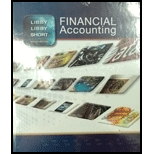
1.
Prepare T-accounts of Company S.
1.
Explanation of Solution
T-account:
T-account refers to an individual account, where the increases or decreases in the value of specific asset, liability,
This account is referred to as the T-account, because the alignment of the components of the account resembles the capital letter ‘T’.’ An account consists of the three main components which are as follows:
- (a) The title of the account
- (b) The left or debit side
- (c) The right or credit side
T-accounts of company S are as follows:
| Cash | |||
| Beg. | 0 | ||
| (a) | 40,000 | 4,000 | (c) |
| 1,000 | (d) | ||
| 35,000 | |||
| Short-Term Notes Receivable | |||
| Beg. | 0 | ||
| (e) | 4,000 | ||
| 4,000 | |||
| Land | |||
| Beg. | 0 | ||
| (b) | 16,000 | 4,000 | (e) |
| 12,000 | |||
| Equipment | |||
| Beg. | 0 | ||
| (c) | 20,000 | ||
| (d) | 1,000 | ||
| 21,000 | |||
| Short-Term Notes Payable | |||
| 0 | Beg. | ||
| 16,000 | (b) | ||
| 16,000 | |||
| Long-Term Notes Payable | |||
| 0 | Beg. | ||
| 16,000 | (c) | ||
| 16,000 | |||
| Common Stock | |||
| 0 | Beg. | ||
| 10,000 | (a) | ||
| 10,000 | |||
| Additional Paid-in Capital | |||
| Beg. | |||
| 30,000 | (a) | ||
| 30,000 | |||
2.
Prepare the
2.
Explanation of Solution
Trial balance:
Trial balance is the summary of accounts, and their debit and credit balances at a given time. It is usually prepared at end of the accounting period. Debit balances are listed in left column and credit balances are listed in right column. The totals of debit and credit column should be equal. Trial balance is useful in the preparation of the financial statements.
Trial balance of Company S is as follows:
| Company S | ||
| Trial Balance | ||
| December 31, 2014 | ||
| Particulars |
Debit ($) |
Credit ($) |
| Cash | 35,000 | |
| Short-term notes receivable | 4,000 | |
| Land | 12,000 | |
| Equipment | 21,000 | |
| Short-term notes payable | 16,000 | |
| Long-term notes payable | 16,000 | |
| Common stock | 10,000 | |
| Additional paid-in capital | 30,000 | |
| Totals | 72,000 | 72,000 |
Table (1)
Therefore, the total of debit, and credit columns of trial balance is $72,000 and agree.
3.
Prepare the balance sheet of Company S.
3.
Explanation of Solution
Classified balance sheet:
This is the financial statement of a company which shows the grouping of similar assets and liabilities under subheadings.
Classified balance sheet of Company S is as follows:
| Company S | ||||
| Balance sheet | ||||
| December 31, 2014 | ||||
| Assets | $ | Liabilities | $ | |
| Current assets: | Current liabilities: | |||
| Cash | 35,000 | Short-term notes payable | 16,000 | |
| Short-term investments | 4,000 | Total current liabilities | 16,000 | |
| Total current assets | 39,000 | Long-term notes payable | 16,000 | |
| Total liabilities (A) | 32,000 | |||
| Land | 12,000 | Stockholders' equity | ||
| Equipment | 21,000 | Common stock | 10,000 | |
| Additional paid-in capital | 30,000 | |||
| Total stockholder's equity (B) | 40,000 | |||
| Total assets | 72,000 | Total liabilities and stockholder’s equity | 72,000 | |
Table (2)
Therefore, the total assets of Company S are $72,000, and the total liabilities and stockholders’ equity is $72,000.
4.
Calculate the current ration of Company S for 2014, 2015 and 2016, and also suggest about the company.
4.
Explanation of Solution
A part of
Current ratio of Company S is as follows:
| Year | Current ratio |
| 2014 | 2.44 (1) |
| 2015 | 2.26 (2) |
| 2016 | 1.18 (3) |
Table (3)
In this case, the liquidity of Company S decreased over the three years, because the current ratio of company has decreasing tendency. So, company has difficult situation to repay the current obligation.
Working note:
Calculate current ratio for 2014
Calculate current ratio for 2015
Calculate current ratio for 2016
5.
Describe the recommendation about lending money to Company S.
5.
Explanation of Solution
The bank’s vice president should not lend loan to Company S, because current ratio of company has decreasing tendency over the three years. It indicates company S has difficult situation to repay the current obligation of business, and it creates problem to repay the loan. So, the vice president of bank should not provide loan to Company S.
Want to see more full solutions like this?
Chapter 2 Solutions
Financial Accounting - With Access

 AccountingAccountingISBN:9781337272094Author:WARREN, Carl S., Reeve, James M., Duchac, Jonathan E.Publisher:Cengage Learning,
AccountingAccountingISBN:9781337272094Author:WARREN, Carl S., Reeve, James M., Duchac, Jonathan E.Publisher:Cengage Learning, Accounting Information SystemsAccountingISBN:9781337619202Author:Hall, James A.Publisher:Cengage Learning,
Accounting Information SystemsAccountingISBN:9781337619202Author:Hall, James A.Publisher:Cengage Learning, Horngren's Cost Accounting: A Managerial Emphasis...AccountingISBN:9780134475585Author:Srikant M. Datar, Madhav V. RajanPublisher:PEARSON
Horngren's Cost Accounting: A Managerial Emphasis...AccountingISBN:9780134475585Author:Srikant M. Datar, Madhav V. RajanPublisher:PEARSON Intermediate AccountingAccountingISBN:9781259722660Author:J. David Spiceland, Mark W. Nelson, Wayne M ThomasPublisher:McGraw-Hill Education
Intermediate AccountingAccountingISBN:9781259722660Author:J. David Spiceland, Mark W. Nelson, Wayne M ThomasPublisher:McGraw-Hill Education Financial and Managerial AccountingAccountingISBN:9781259726705Author:John J Wild, Ken W. Shaw, Barbara Chiappetta Fundamental Accounting PrinciplesPublisher:McGraw-Hill Education
Financial and Managerial AccountingAccountingISBN:9781259726705Author:John J Wild, Ken W. Shaw, Barbara Chiappetta Fundamental Accounting PrinciplesPublisher:McGraw-Hill Education





